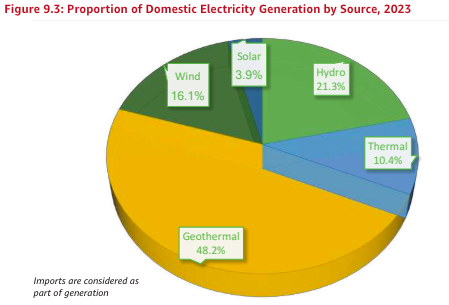While total electricity demand in Kenya increased from 12,985.4 GWh in 2022 to 13,423.6 GWh in 2023, domestic demand for electricity increased by 3.1 per cent to 10,320.6 GWh in 2023.
- •According to the recent Kenya Economic Survey by the Kenya National Bureau of Statistics (KNBS), despite an increase in demand, the total installed electricity generating capacity decreased from 3,321.3 MW in 2022 to 3,243.6 MW in 2023.
- •Subsequently, effective electricity generation capacity declined by 1.7 per cent to 3,112.7 MW in 2023.
- •Total electricity generation rose by 3.4 per cent to 13,423.6 GWh in the review period, despite a notable decrease of 17.6 per cent in thermal generation to 1,305.7 GWh in 2023.
Similarly, hydro power generation declined by 12.3 per cent to 2,666.7 GWh in the same period. In contrast, solar power generation increased by 28.1 per cent to 491.5 GWh in 2023 while geo-thermal power generation increased by 9.3 per cent to 6.0 thousand GWh in the review period.
Wind electricity generation decreased by 134.9 GWh to 2,008.1 GWh in 2023, while the amount of geothermal electricity generated increased by 9.3 per cent to 6,032.1 GWh in 2023.
However, hydroelectric power generation declined by 12.3 per cent to 2,666.7 GWh in 2023 as solar generation rose from 383.7 GWh in 2022 to 491.5 GWh in 2023.
Proportion of Domestic Electricity Generation by Source
Renewable sources accounted for 89.6 per cent of local electricity production in 2023. Geothermal generation remained the main source of electricity generation, contributing 48.2 per cent of the total local electricity generated, followed by hydro generation at 21.3 per cent, and wind generation at 16.1 per cent.
Thermal oil was the only source of non-renewable energy source in 2023, contributing 10.4 per cent to the total local electricity generation.
Imports of electricity almost tripled to 919.3 GWh on account of full operationalization of Ethiopia High Voltage Direct Current (HVDC) Power plant, with export sales also increasing by 58.6 per cent to 33.8 GWh in 2023.
Transmission and distributive losses amounted to 3,069.2 GWh, accounting for 22.9 per cent of total demand in 2023.
The total effective capacity of electricity decreased by 1.7 per cent to 3,112.7 MW in 2023. In the review period, thermal oil electricity’s effective capacity declined by 9.1 per cent to 586.6 MW in
During the review period, the effective capacity for solar energy remained constant at 212.2 MW. In addition, geothermal effective capacity increased by 5.0 MW to 876.1 MW in 2023, while that of cogeneration remained constant at 2.0 MW in the review period.
In 2023, the sector’s real Gross Value Added (GVA) grew by 2.9 per cent compared to 5.7 per cent growth recorded in 2022. The growth was mainly supported by increase in electricity sales which increased from 12,985.4 GWh in 2022 to 13,423.6 GWh in 2023.
The deceleration was mostly attributed to a decline in domestic electricity generation which declined by 1.4 per cent to 12,498.1 Gigawatt Hour (GWh) in 2023. Specifically, electricity from Hydro and Thermal generation declined by 12.4 per cent and 17.6 per cent in 2022 to stand at 2,662.7 GWh and 1,305.7 GWh respectively in 2023.
However, electricity generated via geothermal expanded by 9.3 per cent reaching 6,030.1 GWh in 2023. Electricity imports surged from 316.0 GWh in 2022 to 919.3 GWh in 2023 while exports also increased from 21.3 GWh in 2022 to 33.8 GWh in 2023.
During the review period, the average yield for domestic consumer category rose by 34.6 per cent to KSh 22.75 per unit, while street lighting categories declined by 1.7 per cent to KSh 9.56 per unit of electricity sold. During the same period, the average electricity yield for the commercial industrial category increased by 14.8 per cent to KSh 19.00 per unit.
Similarly, the average electricity yield for the exports category rose by 24.6 per cent to KSh 20.88 in 2022/23, while the yield for the small commercial category increased by 14.4 per cent to KSh 23.14.
See Also:







